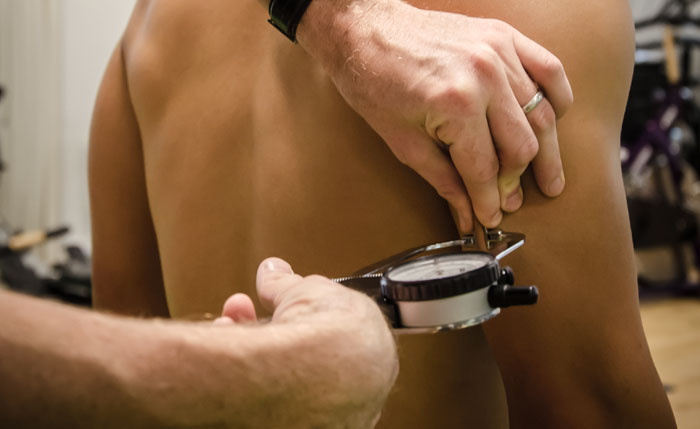In todays article I want to look at the use of skinfold measurements as a method for measuring body fat.
Making use of numbers and data can be an extremely useful tool to help both motivate clients and determine the effectiveness of certain protocols or methods you might be using.
Over time there has been an array of methods created to help determine body fat these include:
- Skinfold Measurements
- Bioelectrical Impedance
- BodPod
- DEXA Scanning
All of the above have their benefits and draw backs, some more than others, but today I want to first start by reviewing the positives and negatives of skin fold analysis.
Skinfold analysis for body composition
Skinfold analysis is something that has been about for years. I first learnt skinfold analysis during my degree back in 2002.
In recent years the use of skinfold assessments to determine body fat has been popularised, particularly in the personal training field through courses associated with strength coach Charles Poliquin and his systems Biosignature / Bioprint. Other than an extravagant way to sell supplements, do these methods used actually give us a good predictor of body fat percentage and lean muscle mass?
As with early uses of skinfold assessment, your height, weight, age and certain skinfold sites are added into an equation to give you an estimate of your current body fat levels.
Practitioners will use methods that range from taking just 3 sites, all the way up to 14 sites on the body depending on the equation they are using to determine your body fat percentage.
Potential flaws in skin fold analysis
As well as variations in the end body fat and lean mass predictions based upon the different equations, you also have significant differences in how the skinfolds are taken from one practitioner to another.
In the past I have experimented with this and have had three different practitioners take my body fat within a 1-2 day period.
Much to my amazement depend on the type of method used the levels of body fat varied significantly, both for individual skinfolds and also the end body fat percentage number.
Upon totaling up the sum of 12 for 3 different practitioners I noticed around a 20% variation in the sum of all skin folds.
Not only that but when the data was used to insert into a variety of equations there was almost an 80% difference from one equation to another using one of the practitioners numbers. This also meant a swing in lean mass of almost 5kg from one equation to another.
As you can see there is a significant variation in both the measurements taken from each practitioner and also between the results from the variety of equations available.
Can and should we still use callipers?
Irrespective of this I will still continue to use skinfold assessments as a tool in the box when consulting with clients. You might ask why, when there is such a discrepancy of results.
In my opinion it should not be used as an accurate way to determine body fat, but can be used to determine if your protocol is moving in the right direction. However I will add a note to this point, having seen a number of DEXA scan results and comparing the results with the new Bioprint software this appears to be the most strongly correlated, and from my understand the Bioprint software was developed utilising DEXA scanning, which can be seen as the gold standard in body fat analysis.
Another benefit with skinfolds is that they are not dramatically affected by glycogen and water changes like bioimpedence analysis, such as the hand held ones or the stand on bathroom scales that you often see used. Purely from the point of view of gathering data on specific site levels of subcutaneous fat it can still be an effective tool for continually tracking progress.
How can you make the skinfolds more accurate?
One of the major downfalls is the variation in measurements from one practitioner to another. So here are some tips if you are going to have your skinfolds assessed:
- Stick to one practitioner.
- Try to pick a practitioner with a lot of experience taking measurements.
- If they are less experienced have them mark your body in th exact location and take your measurements 3 times and take a mean of the 3 skinfolds.
- Look for patterns
- By this I mean look for patterns over the weeks/months for progress to determine if you are moving forward.
- Also look for patterns on the day of testing. If all sites are dropping down, you can be sure your overall levels are dropping down.
- Rely more upon the individual site measurements and the total sum of the measurements you are taking to determine changes in body fat.
Always remember a percentage is just a number. How you feel, how you perform and if required how you look are the best markers of all.
If you are looking for an accurate way to measure your body fat percentage, visceral fat and lean mass, you might want to look into DEXA scanning. I work with a private lab close to my clinic in Marylebone who are able to conduct DEXA scan tests on my clients.
Contact Steve Grant Health
To learn more out how Steve Grant Health can assist you on your journey, please fill out the enquiry form below.
Please note that depending on your specific circumstances and goals, Steve may recommend that you work with one of the specialist practitioners within his network of trusted professionals.
If you have been referred by a clinician, please complete the form and ensure that you state who has referred you or have your practitioner email Steve direct to make a referral that way.
Click the button below to open the client enquiry form:
[widgetkit id=”643″]


